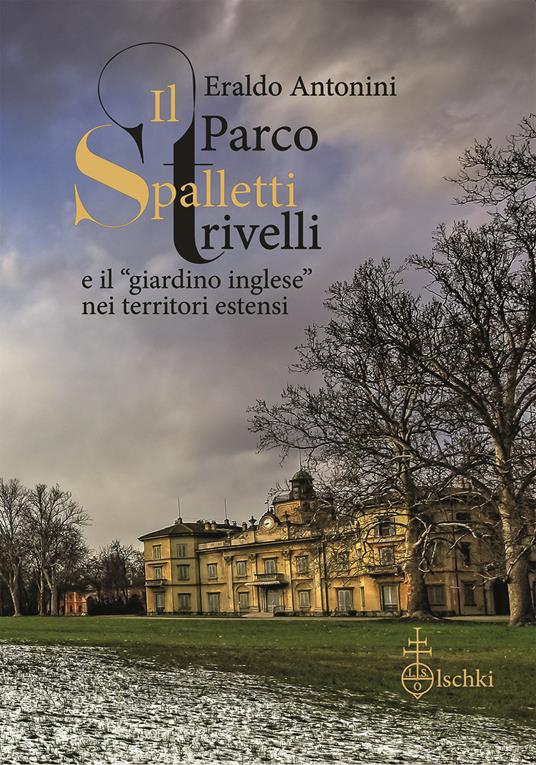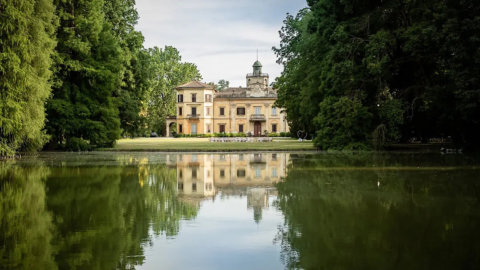The volume edited by has been published Olschki entitled "Spalletti Trivelli Park and the English Garden” in the extensive territories edited by Eraldo Antonini.
The book, which draws inspiration from the analysis of the political and cultural context of the time and the social and economic history of the owner family, covers the stages of the design and transformation of the garden in the eighteenth-century estate of the Marquises Giannini, the first English garden of the first half of the nineteenth century up to the large park of the second half of the same century.
The nineteenth-century fashion of the "English Garden"
1843 opened under grim omens for Gian Battista Spalletti Trivelli due to the premature death of his brother William in Vienna in January of that year. Despite this, Gian Battista began work on the new garden with a construction detail that could compete with other gardens already present in the Duchy of Modena and Reggio. For example, Duke Francesco IV is remembered, who had renovated the ducal garden with a landscape taste coming from across the Channel. Furthermore, the Marquise Ippolita Levizzani Sorra, after demolishing the eighteenth-century garden of Gaggio in Piano, on the border with the Papal States, had an English garden built, praised by the court poet Antonio Peretti.
From the Spalletti Trivelli archive there is no indication of who was the author of the project English garden of San Donnino. According to past hypotheses there would be an attribution of paternity to the ducal head gardener Karl Huller. Considering instead the analogies with the layout of the garden of Villa Sorra in Gaggio in Piano, the possibility of an intervention of Giovanni de' Brugnoli by Brunnhoff, director of the Botanical Garden of Modena.
The hut is another element that appeared in the English garden
Its presence evoked simple, rural life and was often placed within the woodland "scene" as in the case of the wooden "hut" in the garden. Another element present in English gardens between the end of the 700th and the beginning of the 800th century was the grotto which mainly had an evocative function which was intended to refer to the origins of man when he lived in caves and represented a reference to the water lilies of Greek mythology and Roman.
The English Garden conceived as an initiatory path of Masonic inspiration
In the esoteric sphere, the various architectural elements that were placed in the English garden such as the arch, the columns, the hut, the pyramid, the obelisk and the cave were Masonic references to the Masonic initiatory path which was often represented inside the gardens. After all, the English garden had had, from the outset, a esoteric-Masonic matrix.

In Italy some gardens that refer to this symbolism are: the English garden of the Royal Palace of Caserta wanted by Maria Carolina of Austria of Habsburg Lorraine, sister of the Archduke Ferdinand, father of the future Duke of Modena Francis IV. The garden was designed by Carlo Vanvitelli (1730-1821) and the gardener and botanist Johann Andreas Graeffer (1746-1802) and included statues, a pyramid, an obelisk, temple ruins and archaeological finds. We find many other examples in Lombardy and Tuscany.
However, it is difficult to understand whether Spalletti Trivelli also wanted to create a newly built English garden which was also an initiatory path of Masonic inspiration.
The volume also features a whole series of dedicated chapters to the vegetable component, the renovation of the buildings, the concierge, the Swiss cottage, the summer house, the choice of plants, the gardeners and the seed suppliers. Interesting the second part of the book where tlet's break the Registry of the plants grown in the park and in the Spalletti Trivelli nurseries in San Donnino in Liguria, all illustrated by photographic plates of the environments and people who lived there.
Notes on the author Ernaldo Antonini
Eraldo Antonini, an agronomist, he was a contract professor of "Restoration, restoration, conservation, reconstruction/evocation of historic gardens", in the Degree Course in Cultural Heritage Sciences of the University of Modena and Reggio Emilia. He has to his credit essays and publications on historic gardens including: Historic Gardens of Emilia Romagna, 2 vols. (2007-2008); The missing garden. Natural and artificial places in the lands of Campogalliano, foreword by Carmen Añon, afterword by Alessandro Tagliolini (1998), participated in the drafting of the Atlas of the Italian Garden (2009). He has carried out consultancy and planning activities in the field of historic gardens including: archaeological park (“villa Neroniana”) of the Municipality of Anzio on the occasion of the Jubilee of 2000, historical study and masterplan for the restoration and conservation of the Coronini Cronberg garden in Gorizia; redevelopment of the "garden of spiers" of the Palazzo Ducale in Sassuolo. Since June 2022 he has been the contact person for the Italian Parks and Gardens Association (APGI) for the Emilia Romagna Region.





